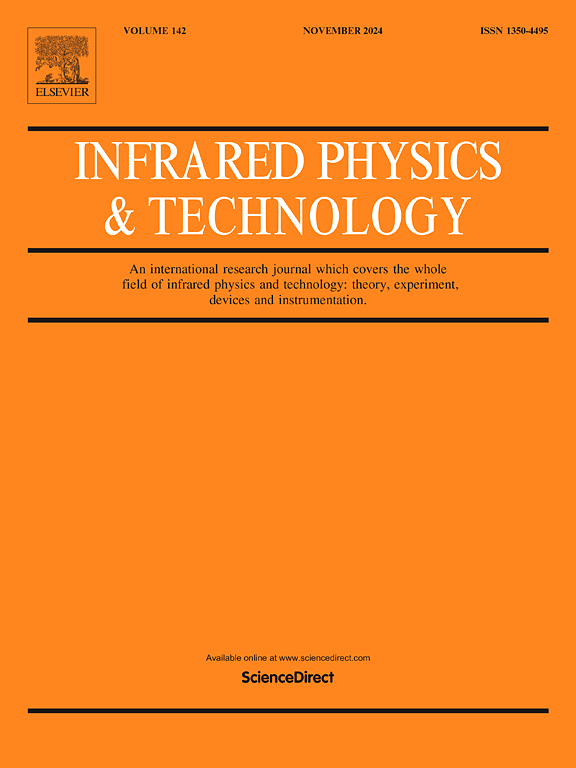低损耗、柔性和鲁棒太赫兹波传输的高性价比外镀铜聚丙烯介电中空波导的结构设计和电镀制造
IF 3.1
3区 物理与天体物理
Q2 INSTRUMENTS & INSTRUMENTATION
引用次数: 0
摘要
为支持太赫兹(THz)6G 有线通信、传感和成像应用,迫切需要低损耗、灵活、坚固且经济高效的波导。根据有限元法的理论分析,提出了一种外部铜(Cu)涂层聚丙烯(PP)太赫兹空心波导(HWG)结构。通过优化波导结构参数,包括内径和壁厚等,实现了 0.1 和 0.3 太赫兹的低理论传输损耗。为了在 PP 管外侧制备致密光滑的铜反射层,建立了一个电镀设备。Cu/PP HWG 样品在 0.1 THz 和 0.3 THz 时的传输损耗分别为 1.83 dB/m 和 1.18 dB/m。波导样品在-78.5/65 °C的环境中以及经过 10 个周期的抗振动测试(10-500 Hz)后,表现出稳健的传输性能(输出功率波动低于 3.7 %)。这项研究为开发低损耗、柔性、耐用和低成本的金属/电介质太赫兹波导提供了不同的见解,对于在实际工程应用中建立可靠的太赫兹波传输系统具有重要价值。本文章由计算机程序翻译,如有差异,请以英文原文为准。
Structure design and electroplating fabrication of cost-effective externally copper-coated polypropylene dielectric hollow waveguide for low-loss, flexible and robust delivery of terahertz waves
There is an urgent demand for low-loss, flexible, robust, and cost-effective waveguides to support terahertz (THz) 6G wired communications, sensing, and imaging applications. An external copper (Cu)-coated polypropylene (PP) THz hollow waveguide (HWG) structure was proposed based on theoretical analysis of the finite element method. Low theoretical transmission losses at 0.1 and 0.3 THz were achieved by optimizing the waveguide structural parameters, including inner diameter and wall thickness, etc. An electroplating apparatus was built up to prepare the dense and smooth Cu reflective layer on the outside of the PP tubes. The transmission losses of the Cu/PP HWG sample at 0.1 THz and 0.3 THz were 1.83 dB/m and 1.18 dB/m, respectively. The waveguide sample exhibited robust transmission behaviors (output power fluctuation below 3.7 %) in −78.5/65 °C environments and after 10 cycles of anti-vibration test (10–500 Hz). This study provided a different insight into developing low-loss, flexible, durable, and low-cost metal/dielectric THz HWG, which would be valuable for establishing reliable THz wave transmission systems in practical engineering applications.
求助全文
通过发布文献求助,成功后即可免费获取论文全文。
去求助
来源期刊
CiteScore
5.70
自引率
12.10%
发文量
400
审稿时长
67 days
期刊介绍:
The Journal covers the entire field of infrared physics and technology: theory, experiment, application, devices and instrumentation. Infrared'' is defined as covering the near, mid and far infrared (terahertz) regions from 0.75um (750nm) to 1mm (300GHz.) Submissions in the 300GHz to 100GHz region may be accepted at the editors discretion if their content is relevant to shorter wavelengths. Submissions must be primarily concerned with and directly relevant to this spectral region.
Its core topics can be summarized as the generation, propagation and detection, of infrared radiation; the associated optics, materials and devices; and its use in all fields of science, industry, engineering and medicine.
Infrared techniques occur in many different fields, notably spectroscopy and interferometry; material characterization and processing; atmospheric physics, astronomy and space research. Scientific aspects include lasers, quantum optics, quantum electronics, image processing and semiconductor physics. Some important applications are medical diagnostics and treatment, industrial inspection and environmental monitoring.

 求助内容:
求助内容: 应助结果提醒方式:
应助结果提醒方式:


